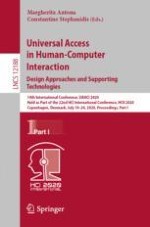2020 | OriginalPaper | Buchkapitel
Usability of User-Centric Mobile Application Design from Visually Impaired People’s Perspective
verfasst von : Hammad Hassan Qureshi, Doris Hooi-Ten Wong
Erschienen in: Universal Access in Human-Computer Interaction. Design Approaches and Supporting Technologies
Aktivieren Sie unsere intelligente Suche, um passende Fachinhalte oder Patente zu finden.
Wählen Sie Textabschnitte aus um mit Künstlicher Intelligenz passenden Patente zu finden. powered by
Markieren Sie Textabschnitte, um KI-gestützt weitere passende Inhalte zu finden. powered by
